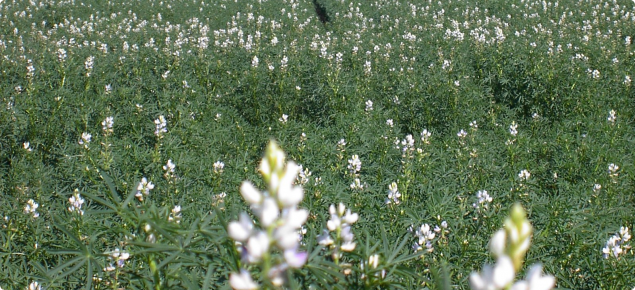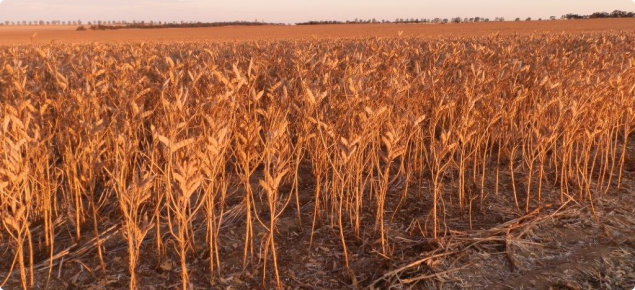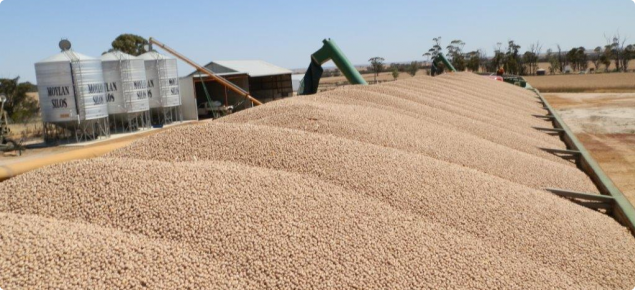Paddock selection
- Sandy textured soils with pH 4.5-7 (calcium chloride - CaCl2) and good depth.
- Avoid saline soils, those subject to waterlogging, alkaline and shallow duplex soils.
- A relatively low weed burden.
- Avoid paddocks with large areas of WA blue lupins particularly in the northern area.
- Ideally paddocks with good stubble from previous year to reduce Brown Spot risk.
- The interval between lupin crops is determined by a number of factors. including; the level of Brown Spot disease and weed burden.
Variety
Variety depends on location and disease risk. Have seed tested for germination, seed size, presence of CMV and anthracnose. The most recent varieties are PBA Gunyidi and PBA Barlock.
Sowing window
Crops should be sown as early as possible: any time after 25 April in the north or early May in the south. Sowing lupins after the first week of June is not recommended in any part of the northern wheatbelt. It is still viable to sow lupins in June in some parts of the southern wheatbelt because losses from delayed sowing in these areas are not as great as in the northern wheatbelt. Lupins grow rapidly when temperatures are higher during May. Rapid germination, emergence and seedling growth allow seedlings to grow away from brown spot disease.
Sowing options
There are three strategies that are commonly used to sow a lupin crop:
- Dry sowing.
- Wet sowing on the break.
- Delaying sowing after the break to enable weed control prior to sowing.
Each lupin sowing strategy has positive (+) and negative (X) consequences and features.
Dry sowing
- (+) Allows the crop to utilise the longest growing season possible.
- (+) Enables rapid crop establishment in warm soil.
- (+)Logistically is simple.
- (X) Simazine incorporation is uneven when applied and tilled in dry soil. This often results in poor simazine activity and subsequent poor weed control and higher weed burdens.
- (X) Germination on marginal moisture can lead to poor and uneven lupin crop establishment.
- (X) Weeds that grow through ineffective control at sowing are difficult and expensive to control within the crop.
- (X) Paddocks are locked into lupin production with the application of simazine prior to the 'break'. It is unwise to commit too many paddocks to lupin in case of a late break.
- (X) Paddocks may be prone to wind erosion if ground cover is sparse.
If lupins are sown dry, take the following precautions;
- Sow into paddocks with good stubble cover to avoid wind erosion.
- Sow into paddocks with low weed burdens.
- Increase seed rate by 10% to buffer against poor establishment.
- Apply slightly more herbicide (+0.2-0.4 litres per hectare (L/ha) of simazine).
- Retain as much anchored cereal stubble as possible.
- Do not dry sow into paddocks where there are WA blue lupins which cannot be controlled with selective herbicides in the crop. In such paddocks, WA blue lupins must have germinated and been killed before the narrow-leafed lupin crop is sown.
Wet sowing on the break (15mm over two days)
- (+) Sowing into wet soil guarantees that an even competitive lupin crop will emerge.
- (+) Simazine applied before the 'break' of the season will be washed into the soil by opening rains. Sowing lupin into wet soil will ensure even distribution of the simazine and maximum weed control. Effective use of pre-emergence herbicide results in fewer weeds in the crop. This places less pressure on post emergence, selective herbicides
Caution: It is unwise to apply simazine before the break and commit too many paddocks to lupin in case of a late break.
- (+) Trifluralin is most effective if incorporated into moist soil at sowing.
- (+) Even crops enable post emergent sprays to be applied effectively.
- (X) If conditions at seeding result in the soil rapidly drying less crop may be established/sown on the first rain.
- (X) The sowing operation leads to drying of the soil which reduces available soil moisture for germination and crop establishment.
Early germinating radish plants produce many seeds if they are not controlled. Ensuring an even healthy crop and using pre seeding herbicides effectively will help control weeds that germinate with the crop.
Delayed sowing
- (+) Allows the use of knockdown herbicides to kill weeds that have emerged. Knockdown herbicides are your cheapest and most effective herbicides.
- (+) Early germinating radish and ryegrass can be easily and cheaply controlled with knockdowns.
- (+) Typically 75-80% of ryegrass seed germinates on the first two substantial rains (20mm or more)
- (+) No simazine applied prior to 'break' of season allowing greater sowing flexibility.
- (+) Sowing into wet soil guarantees that an even competitive lupin crop will emerge.
- (+) Use new varieties like PBA Gunyidi and PBA Barlock.
- (X) There is a risk that there may be a long period between the “break” and follow up rains. This is more likely to occur in low rainfall zones.
- (X) The rate of yield loss resulting from delayed sowing is greater in low rainfall zones.
- (X) Slower lupin germination and establishment due to cooler soil temperatures.
- (X) The sowing program for cereals may be delayed.
Sowing rate
The recommended plant density for narrow-leafed lupin crops is 40-45 plants per square metre. Trials have shown, however, that optimum plant densities change depending on location and season. There is usually little or no yield penalty if plant densities are higher than the recommended range up to 70 plants/m2 but yield losses can be substantial if plant populations decline below 40 plants/m2. Plant density does not only affect yield. Research has shown that keeping lupin crop density high:
- Substantially suppresses weed growth and reduces the effects of competition on the crop.
- Reduces brownleaf spot and cucumber mosaic virus
- Allows the crop to compensate for poor establishment due to sandblasting non wetting soils and root diseases.
- It is usually easier to harvest dense crops.
| Germination rate (%) | Lupin seed weight 140g/1000 seeds | Lupin seed weight 160g/1000 seeds | Lupin seed weight 180g/1000 seeds |
|---|---|---|---|
| 70 | 100 | 114 | 129 |
| 80 | 88 | 100 | 113 |
| 90 | 78 | 89 | 100 |
Row spacing
Wider rows (50cm and greater) are more likely to yield better than narrow rows (18-25cm) in the warm dry environments of the medium and low rainfall northern wheatbelt. Significantly there is no yield penalty going wider.
Narrower rows are most likely to yield better in cooler longer season environments such as the Lakes district and areas further south. In situations where terminal drought is not severe and yield potential is very high, crops in 50cm rows tend to yield less than those in 25cm rows.
Seeding depth
Sow seeds 3-5cm below the soil surface.
Sowing very deep, below 5cm, will reduce the occurrence of pleiochaeta root rot. Shallow sowing (2-3cm) will reduce rhizoctonia hypocotyl rot disease. Because the ideal seed depths to avoid these two diseases are incompatible, a compromise is needed, hence the recommendation of 3-5cm. Seed should never be sown deeper than 7cm as establishment is very uneven and weak.
Inoculation
Lupins and other legumes have the ability to fix their own nitrogen. Rhizobium are required for nodulation and nitrogen fixation by lupins. All lupins sown in a paddock for the first time should be inoculated with rhizobium. On acid soils (pH below 6.5) once a well nodulated lupin crop has been grown in the paddock, a lupin crop will not need to be inoculated for the next five years.
If more than five years has passed, seed should be inoculated. On neutral and alkaline soils (pH above 6.5), the rhizobium do not survive in the soil for long, and seed must be inoculated every time a lupin crop is grown. Lupins should be inoculated with Group G inoculant. Serradella inoculant (Group S) is also compatible with lupins and can be used as a substitute if necessary.
Fertiliser
Use soil test or paddock history to determine fertiliser rates. Drill phosphate at seeding. Banding of phosphate below the seed can increase yields on some soils, particularly those with high phosphorous retention. If needed apply potassium within four weeks of sowing. On potentially manganese-deficient soils (mainly light sands), manganese can be applied as manganese super deep banded under the seed; alternatively it can be applied as a spray when first pods are 2.5cm.
Weed control
Effective weed control is essential for good yields and to avoid the build up of troublesome weeds in the rotation. Plan your weed control strategy before sowing.
Summary of an ideal weed control strategy:
- Where practical, delay sowing to maximise weed kill from knockdown herbicides.
- Maximise the effectiveness of the pre-emergent herbicide simazine by incorporating in wet soil.
- Ensure an even crop so that all plants are at the correct growth stage when post-emergent herbicides are applied.
- Spray small weeds early for an effective kill.
- Use the highest registered rate of post-emergent chemical possible without causing unacceptable crop damage.
- Crop-top with Gramoxone® or Reglone® if required.
Pre-emergent herbicides
Simazine is most effective when incorporated thoroughly into the soil. This is best achieved by applying simazine before the "break" so it will be washed into the soil by the opening rains and then sowing the lupin crop into the wet soil.
Caution: While simazine is most effectively applied before the opening rain it is unwise to commit too many paddocks to lupin in case of a late break.
Soil type will influence the maximum rate of simazine (600g/kg a.i) that can be applied. In Western Australia, 0.83-1.7L/ha is registered on light soils. 1.7-2.5L/ha is registered for use on gravely loam soils.
- On deep white, grey and gritty sands simazine can damage lupins at low rates (0.8L/ha or less).
- On yellow sandplain soils, crop damage may be observed at 1.25L/ha
- On loams gravely loams and sand over clay simazine rates 1.5L – 2.0L/ha can generally be used with good crop safety.
Trifluralin can also be added if grass weeds are expected to be bad.
Post-emergent herbicides
Many weed populations have some tolerance to post-emergent herbicides.
To control these weeds apply post-emergent herbicides early and use the highest registered rate possible without causing unacceptable crop damage.
- Spray small weeds early
- Apply top-up simazine, diflufenican, picinolinafen when radish has 2-6 leaves.
- Target radish smaller than 250mm diameter with metribuzin.
- Use Eclipse® for controlling radish larger than 250mm.
- Target ryegrass before tillering.
- Crop timing
- Use metribuzin on tolerant varieties, PBA Gunyidi and PBA Barlock, when plants have four leaves until bud emergence.
- Use Eclipse® when plants have eight leaves until bud emergence.
Crop-topping
- Crop-top when 80% of leaves have fallen off the lupin plants.
- Gramoxone® is registered at 400-800mL/ha for ground application only.
- Reglone® is registered at 1-2L/ha for application by a mister and plane as a harvest aid.
Insect control
Lupin crops are more prone to insect damage than cereal crops and need to be checked at critical periods for insects.
- Emergence - three weeks post emergence: red legged earth mite, cutworm and lucerne flea
- Flowering: aphids
- Pod fill: native budworm
Disease control
Lupins are susceptible to a wide range of diseases. Roots, hypocotyls, stems, pods and seeds of lupin are all subject to infection by disease organisms. Several of these diseases have the capacity to cause catastrophic losses, but this is rare if management guidelines are followed.
Key steps in the integrated management of lupin diseases include crop rotation, stubble management, fungicide or pesticide application, variety selection and seed testing.
On old lupin country seed should be treated with either iprodione (for example, Rovral®) or procymidone (for example, Sumisclex®) to reduce the risk of pleiochaeta root rot.
To reduce the transmission of seed borne anthracnose seed should be treated with thiram seed dressing at the rate of 100g active ingredient per 100kg of seed. Thiram is not compatible with rhizobium inoculums.
Harvest
Harvest lupin crops as soon as they are ripe. Delays can result in significant loss of yield due to lodging, pod shattering and pod drop. Start harvesting as soon as the moisture content reaches 14%. In some seasons this will occur when the stems are still pale green.
Harvest losses can be substantially reduced by harvesting when humidity is high. Lupin plants strip well during the night and early morning, if possible do not harvest in the middle of the day when it is very hot. In cooler southern environments, daytime temperatures often do not become warm enough to cause major problems for harvest.
In these areas it may be better to harvest the crop as quickly as possible rather than swapping between lupin and cereals. Take special care when harvesting seed for next year’s crop. Harvest it as soon as it is mature. Set the harvester drum or rotor speed to a minimum and the concave opened fairly wide.
This will reduce damage to the embryo and help to ensure a high germination percentage. The seed embryo is very sensitive to impact if it becomes dry and brittle. Even seed with no visible damage may have low percentage germination if it suffered a high impact when its moisture content was low.





